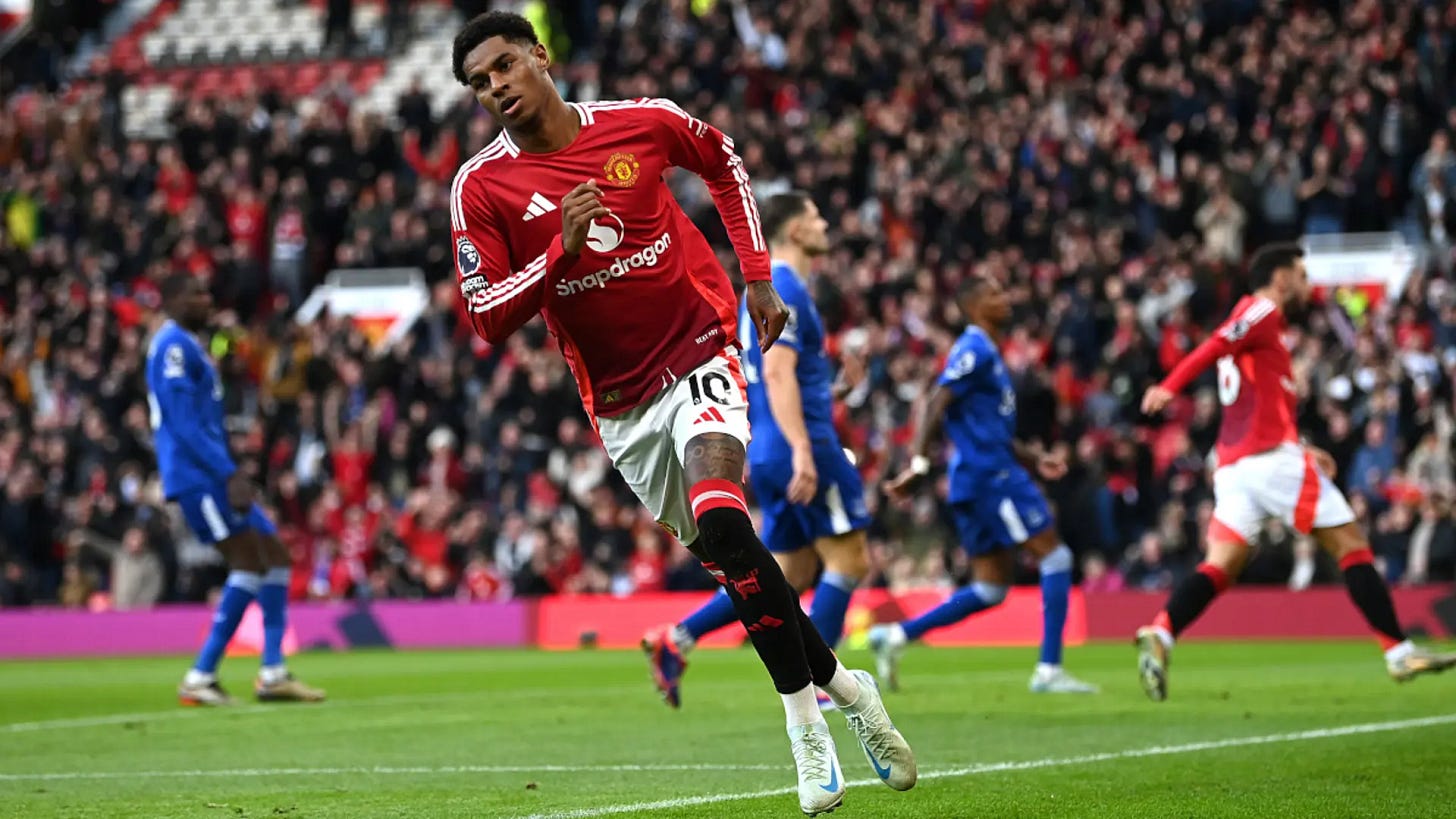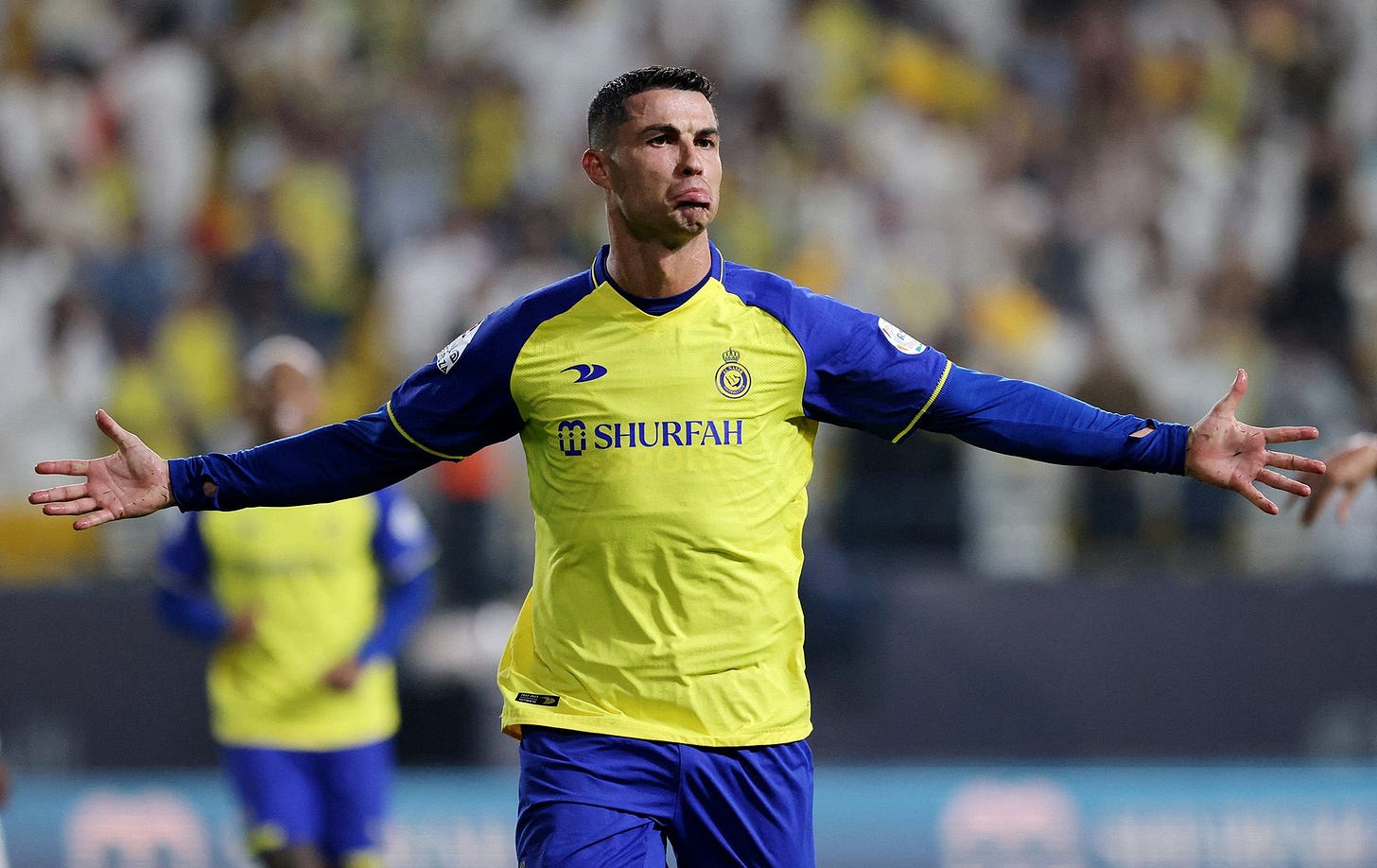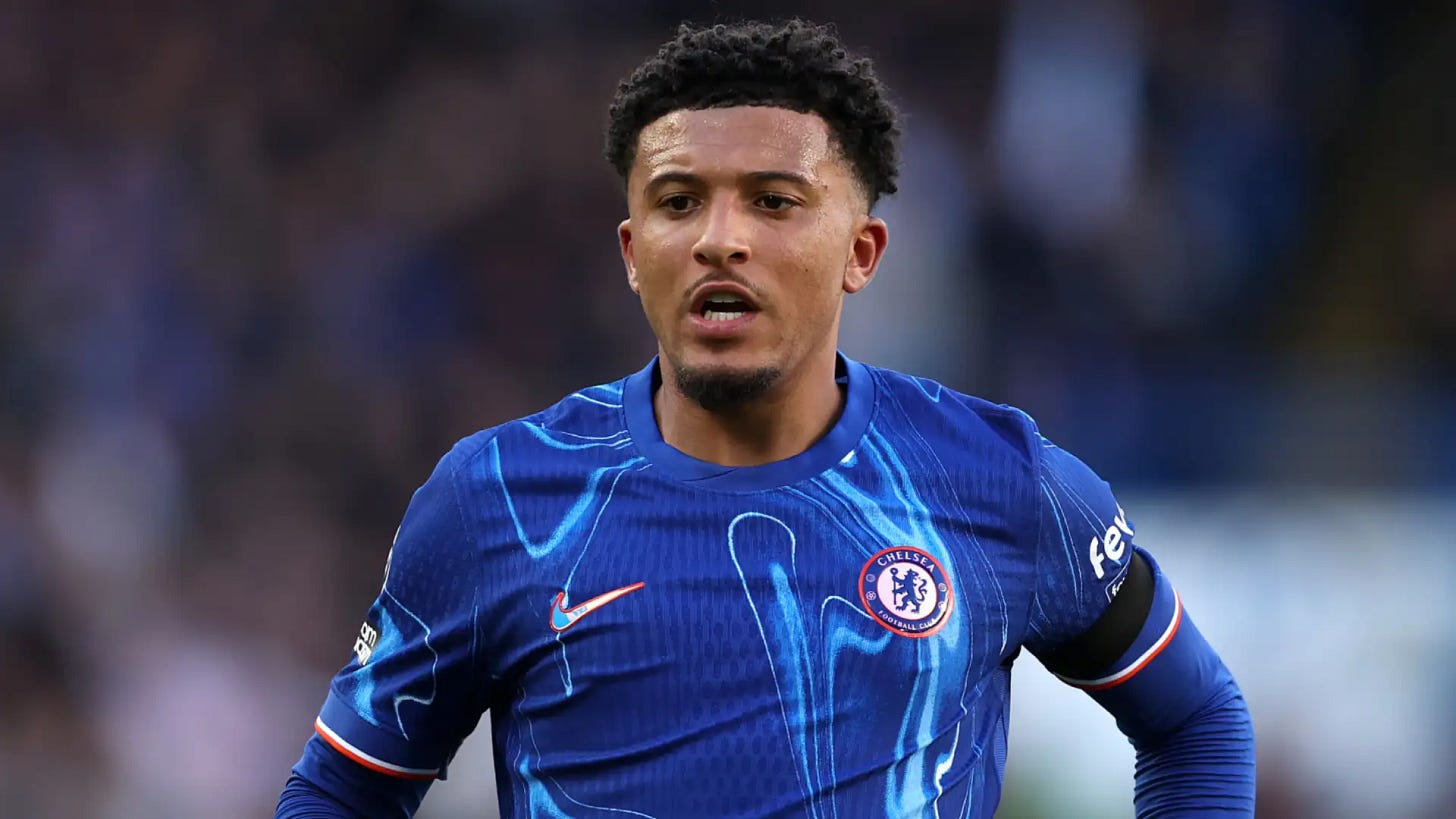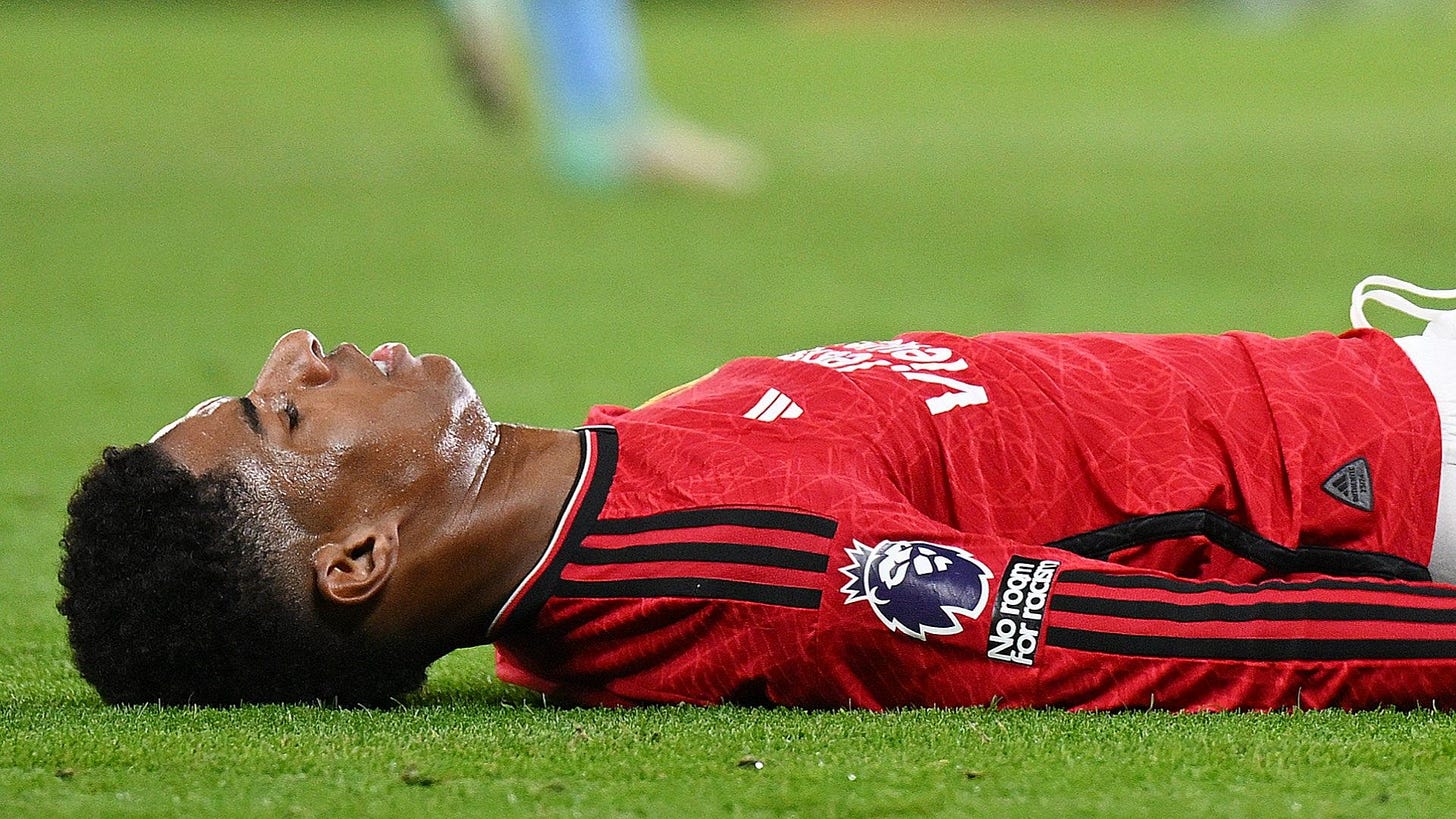Marcus Rashford has been a central figure at Old Trafford since his senior debut in 2016. Now 27, Rashford’s future at United hangs in the balance, a situation carrying significant financial and sporting implications as the INEOS-led ownership team attempts to stabilise the club. Rashford’s potential exit presents multiple scenarios, each tied closely to the Premier League’s Profit and Sustainability Rules (PSR).
The Sporting Context: Rashford’s Recent Performance
Analysing Rashford’s recent form provides context to any decision about his future. In the 2023/24 season, Rashford recorded 11 goals and 8 assists in all competitions, a significant drop from the 30-goal campaign he enjoyed the season before. And while this essay isn’t about his form there are some basic indicators. His current goals-per-game ratio has dropped significantly from his career average and his shot conversion rate has fallen too.
Fans have criticised Rashford’s workrate although the data for what is a very contextual metric is less obvious. In the meantime, Rashford remained a reasonable creative outlet, ranking highly last season for progressive carries and key passes among forwards in the top European leagues.
There are many theories for Rashford’s on-the-field challenges in the past 18 months - tactical (Ten Hag’s insistence on a wide deeper role), personal (the entourage and rumoured off-the-field professionalism, fuelled by Andy Mitten’s vague comments on Talksport), physical (at 400+ games decline can set in). The goal here isn’t to mimic the toxic discourse online where fans are happy to make claims without evidence.
It is fair to ask questions about whether Rashford’s falling contribution justifies his place in the team and therefore the financial impact on the club, especially given United’s current budget constraints.
This juxtaposition of declining output and enduring potential underscores the complexity of United’s decision with the January transfer window set to open on Wednesday. Retaining Rashford offers the hope of resurgence if Head Coach Ruben Amorim can work his magic. Selling an academy player would free up significant resources for others who might better fit Amorim’s tactical approach.
Understanding PSR and United’s Financial Context
The Premier League’s PSR allows clubs to incur a maximum loss of £105 million over a rolling three-year period. United’s financial disclosures show net losses of £113.2 million for the 2023/24 season, contributing to a cumulative three-year loss of £254.7 million.
To put this into even starker terms, United owe other clubs £413.9m in transfer fees, with £203.9m due inside the next 12 months. Add that to the £537m in net debt, which will need to be refinanced in 2027, and every move the club makes has a critical financial impact.
The club maintained PSR compliance in the last cycle, citing allowable adjustments for infrastructure investments and exceptional COVID-related expenses, including a lost tour and sponsorship misses. It was tenuous but allowable.
Rashford’s contract, which extends until 2028, reportedly places him among United’s highest earners. His wage and any potential transfer fee are central to United’s considerations in light of ongoing PSR constraints. By reducing salary costs and securing a fee for an academy product, United could significantly enhance the club’s short-term financial flexibility.
United has made significant efforts to reduce the overall wage budget in recent years as evidenced in both annual reports and UEFA’s benchmarking study.
[It’s worth noting that any wage figure above £300,000 peer week, so often cited in print and social media, would mean that Rashford earns ~10% of United’s annual wage budget. The best estimates for United’s current wage budget is between £180m and £200m. For a number of reasons - trust me bro’ - it is highly unlikely to be the case that Rashford earns this much.]
Scenario 1: Sale to the Saudi Pro League
In this scenario, United secure a substantial transfer fee of £50 million from a Saudi Pro League (SPL) club. The fee, even if paid in instalments over a five-year deal, would be immediately accounted for in United’s financial statements, because Rashford is on United’s books at a zero asset value having come through the academy. In theory, a £50m fee for an academy product allows £250m in immediate spending, although that must be backed up with revenue in future years. There’s no magic money tree here folks. The additional wage savings would further alleviate financial pressure/open up fresh acquisition possibilities.
The SPL is backed by significant state funding, with four state-owned and four state-aligned clubs. It’s a plausible destination for Rashford, despite a slowdown in foreign player acquisitions in recent windows. A sale to Saudi Arabia would be United’s best-case scenario financially, particularly if Rashford does not fit into Amorim’s plans. Whether the player is interested in a move away from Europe is a question yet to be tested.
Scenario 2: Sale to a European Club
A transfer to a European club, likely for a lower fee of around £30 million, is another option. Only a handful of clubs—such as Real or Atletico Madrid, Bayern Munich, PSG, or at a push, Juventus—have the financial resources to afford Rashford’s total package plus fee. While the upfront payment would be less than in any Saudi deal, it still positively impacts United’s revenue and PSR compliance.
A European move might also align better with Rashford’s career ambitions, as few players in their peak years have opted for SPL moves to date. Removing his wages from the books would still provide significant financial relief, freeing resources for acquisitions or preventing further austerity measures in other areas of the club.
Scenario 3: Loan with an Option or Obligation
A loan move with an option or obligation to buy represents a realistic compromise. For example, reports suggest that Atletico Madrid are interested in a January 2025 loan, with United subsidising a significant percentage of his wages during the six-month loan period. An obligation to purchase in the summer for £25-30m would be a structure similar to the one United accepted for Jadon Sancho.
While this arrangement provides immediate wage savings, the deferred transfer fee to the the next financial year represents a less optimal solution. Loans inherently carry risk too, particularly if Rashford’s performance does not tick up. However, it might allow United to retain some optionality over Rashford’s future while addressing short-term financial needs.
Scenario 4: Reintegration
The online sentiment may not favour reintegration (nor it seems do INEOS or Amorim), but retaining Rashford offers the opportunity to rebuild a player who has shown world-class potential in the past. Amorim has publicly expressed a willingness to assist Rashford, suggesting that this is a viable option, and brought the player back into the squad for United’s defeat against Newcastle on Monday night.
This scenario provides no immediate financial gain, of course. With European football in 2025/26 looking unlikely as of going to print, United might need to explore alternative strategies to comply with PSR and refresh the squad in Amorim’s image. These could include increasing commercial revenue - though from what source is a six-year long problem - optimising operational efficiencies (i.e for more budget cuts), or selling alternative high-value players who are less central to Amorim’s long-term vision.
Wanna Bet? Strategic Considerations
Each scenario presents distinct trade-offs between financial and sporting priorities. A high-value sale to a wealthy club offers an immediate financial boost and squad-building flexibility, making it the optimal choice if Amorim has no plans for Rashford. A European transfer provides moderate financial benefits. Reintegration requires a long-term commitment to rebuilding Rashford’s form. A loan-to-buy is a last resort, but may be the most pragmatic if United want a deal completed this winter.
Under the new INEOS leadership, United’s broader objectives must also be considered. With cuts affecting everything from the women’s team to back-office staff, charities, and the former players’ association, the club’s financial strategy will shape its sporting future. Rashford’s fate could become a litmus test for the balance between financial pragmatism and preserving the club’s identity.
Will Rashford be the spark United need to reignite their season? Or will his departure provide a financial boost necessary to rebuild? The next few months will be decisive for player and club alike.









Question, when AWB left United he took a pay cut but to cover his lost earnings United had to pay him off. Reportedly his transfer fee was £15 million and the pay off was £7 million so almost half his transfer fee went straight back out.
If Rashford does go to a European club for £30 million it’s unlikely he will get the same wages so will have to take a pay cut. Will he get a pay off as well? And if he does how big a pay off will it be given he has three years left on his contract when AWB had one? Are they really going to make as much profit of a sale as they think?
Thanks for succinctly addressing the key points regarding his exit.
"For a number of reasons - trust me bro’ - it is highly unlikely to be the case that Rashford earns this much" I do trust you bro, but I am interested in knowing those reasons.
You should consider doing a monthly podcast on United financials, PSR, business, etc. It might draw your lowest numbers, but the 3 of us that enjoy being educated on those topics would greatly appreciate it 😆.